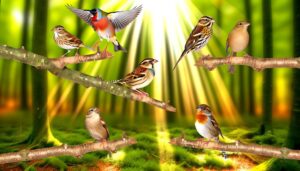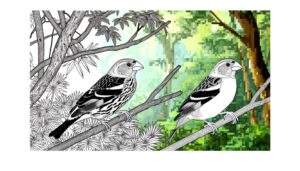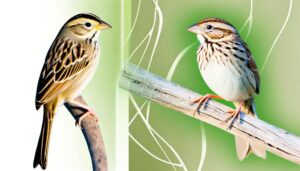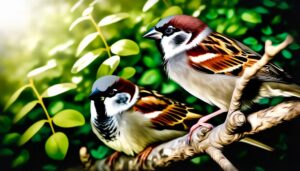A Sparrow vs a Crow: Key Differences
When comparing a sparrow and a crow, several distinctions arise. Sparrows are small, 16-centimeter birds with intricate brown plumage and conical beaks for granivorous diets.
They’re agile fliers, favoring dense vegetation for cover. Crows, on the other hand, are larger, up to 50 centimeters in length, and exhibit all-black feathers with robust, curved beaks suited for an omnivorous diet.
Sparrows communicate with melodious chirps, while crows use harsh caws for social bonding and territorial defense. Each bird’s behavioral adaptations and habitat preferences reveal remarkable survival strategies, inviting further exploration of their unique ecological roles.
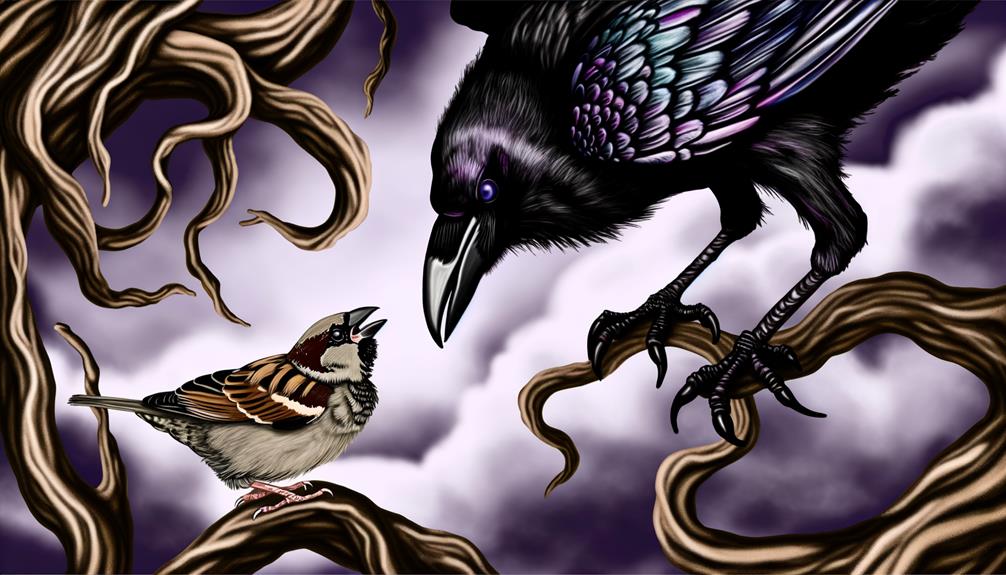
Sparrow vs. Crow: Key Differences in Behavior, Size, and Habitat
| Aspect | Sparrow | Crow |
|---|---|---|
| Size | Small, typically 4.7 to 7.9 inches (12-20 cm) in length | Much larger, about 16 to 21 inches (40-53 cm) in length |
| Weight | Light, usually around 24 to 40 grams | Heavier, ranging from 300 to 600 grams |
| Color | Mostly brown or gray with streaked patterns | Entirely black or dark gray, with a glossy sheen |
| Diet | Seeds, grains, and small insects | Omnivorous: insects, seeds, fruits, carrion, and small animals |
| Social Behavior | Social, often seen in flocks | Highly social, often seen in family groups or large communal roosts |
| Vocalization | Chirps and simple songs | Complex vocalizations, capable of mimicry and varied calls |
| Intelligence | Basic problem-solving skills | Extremely intelligent, known for tool use and problem-solving |
| Lifespan | 3-5 years in the wild, up to 13 in some cases | 7-8 years on average, but some crows can live over 20 years |
| Nesting | Builds small nests in urban areas, trees, or man-made structures | Builds larger nests in trees, tall buildings, and often in colonies |
| Habitat | Common in urban, suburban, and rural areas worldwide | Found in diverse habitats, from cities to forests across the globe |
Physical Appearance
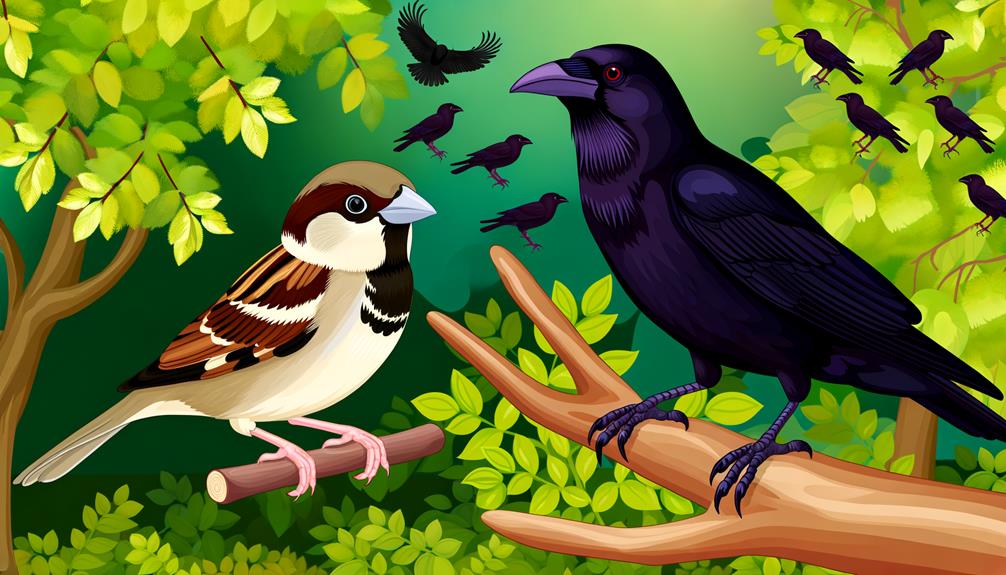
A sparrow’s diminutive size and subtle brown plumage contrast sharply with a crow’s larger frame and striking black feathers. Sparrows exhibit intricate patterns of brown, white, and gray, aiding in their camouflage. Their short, conical beaks are adapted for seed consumption, reflecting their granivorous diet.
Crows, on the other hand, possess robust, all-black feathers that absorb sunlight and may serve thermoregulatory purposes. Their strong, curved beaks are versatile, suitable for an omnivorous diet including carrion and invertebrates. The crow’s iridescent sheen contrasts with the sparrow’s matte finish, indicating health and essentiality within the species.
Observing these avian distinctions reveals evolutionary adaptations, underscoring nature’s complexity. This divergence in physical traits highlights their unique ecological niches and survival strategies.
Size Comparison
Examining their size, sparrows typically measure around 16 centimeters in length and weigh approximately 24 grams, whereas crows can reach lengths of up to 50 centimeters and weigh over 500 grams. This stark contrast in size directly influences their behavioral ecology. Sparrows, with their petite frame, exhibit agile flight patterns and often forage in dense vegetation, maximizing their maneuverability.
Conversely, the crow’s substantial size grants it a dominance in open habitats, enabling it to exploit a wider range of food sources. This size disparity also impacts their predatory and defensive strategies. Sparrows rely on rapid, unpredictable movements to evade predators, while crows utilize their imposing stature to deter potential threats and assert territorial control.
Vocalizations
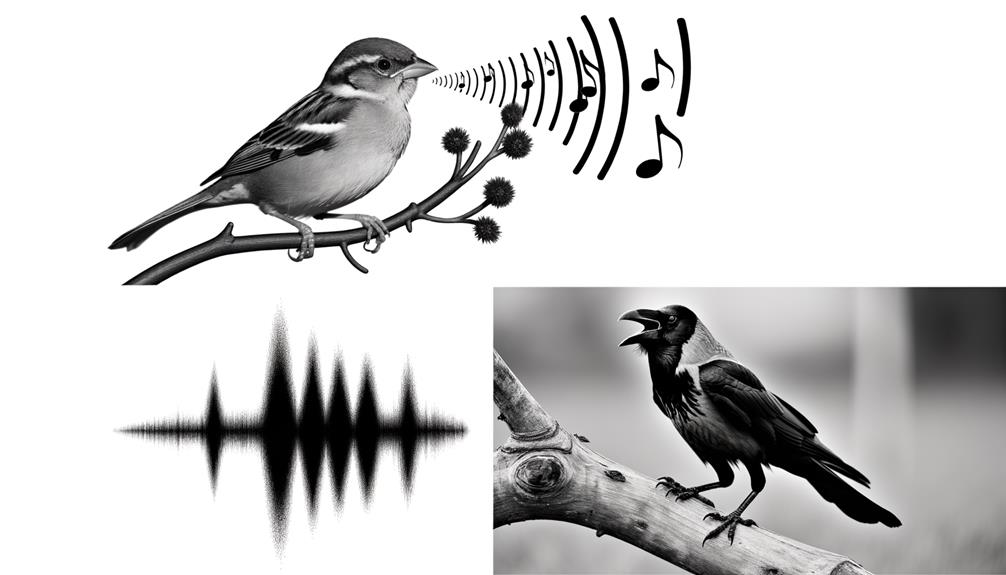
Sparrows and crows demonstrate distinct vocalizations, with sparrows producing melodious chirps and trills that facilitate communication within dense vegetation, while crows emit harsh caws that serve both social bonding and territorial defense in open environments.
Sparrows employ a repertoire of high-pitched notes, essential for staying connected in their intricate habitats. These vocalizations often signify mating calls, alarms, or social interactions.
Conversely, crows’ caws resonate across broader landscapes, playing a pivotal role in their complex social structures. Their vocal range includes varied calls indicating danger, food sources, or group coordination.
This dichotomy in vocal behavior reflects the differing ecological niches and survival strategies of these avian species, highlighting their adaptation to specific environmental demands and social frameworks.
Diet and Feeding Habits
Sparrows exhibit granivorous tendencies, mainly consuming seeds and occasionally insects, while crows display omnivorous feeding behaviors, incorporating a wide range of food sources from fruits to small mammals.
Observational studies highlight that sparrows forage mainly on the ground in a pecking manner, whereas crows exhibit more complex feeding strategies, including tool use and cooperative hunting.
These dietary and behavioral differences underscore the adaptability and ecological niches occupied by each species.
Diverse Dietary Preferences
While both sparrows and crows exhibit omnivorous feeding habits, their dietary preferences diverge based on their ecological niches and anatomical adaptations. Sparrows primarily consume seeds, grains, and small insects, utilizing their short, conical beaks to crack open tough seed coats efficiently. This granivorous inclination ties them closely to agricultural landscapes and gardens.
Crows, on the other hand, display a broader diet, often scavenging for carrion, small mammals, fruits, and human food waste. Their robust, versatile beaks allow them to tear flesh and manipulate diverse food items. These dietary preferences illustrate each species’ ability to exploit different ecological opportunities, highlighting a fascinating divergence shaped by evolutionary pressures and habitat availability, ensuring their survival in varied environments.
Feeding Behavior Differences
Examining the feeding behaviors of sparrows and crows reveals distinct strategies shaped by their respective ecological roles and anatomical adaptations.
Sparrows, primarily granivorous, exhibit pecking behavior, using their conical bills to efficiently crack seeds. They also consume insects, reflecting an opportunistic feeding strategy.
In contrast, crows display omnivorous and highly adaptive feeding habits. Their strong, versatile beaks allow them to forage a wide array of food sources, including fruits, small animals, and carrion. Crows demonstrate remarkable problem-solving skills, utilizing tools and teamwork to access food.
These differences underscore the sparrow’s specialization in seed consumption and the crow’s generalist approach, enabling them to exploit diverse ecological niches and maintain dietary flexibility in varying environments.
Nesting and Breeding
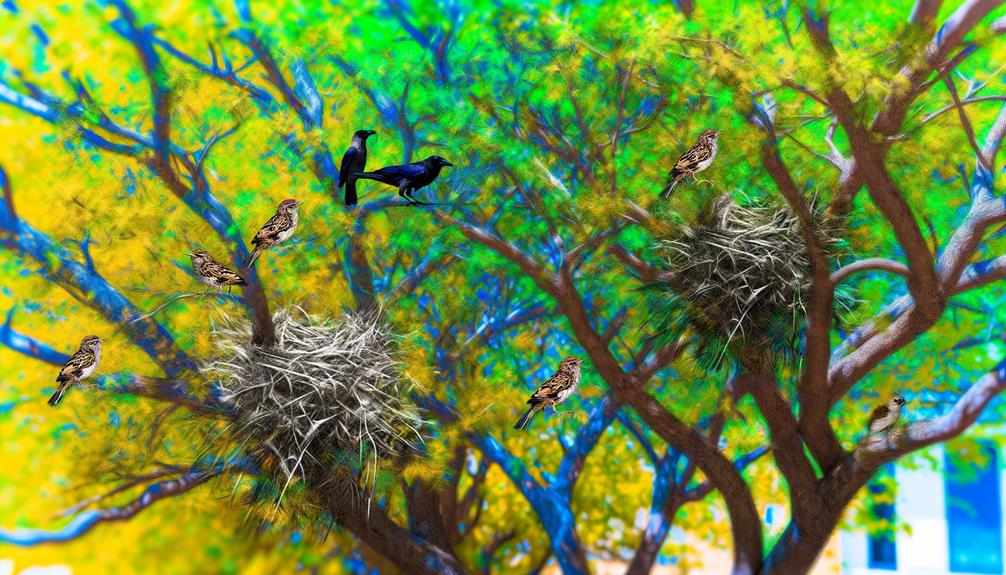
Sparrows exhibit a preference for nesting sites in urban environments, utilizing crevices and eaves of buildings, whereas crows select tall trees or large structures for their nests.
Breeding seasons also differ, with sparrows typically breeding from early spring to late summer, and crows commencing in early spring but extending into early fall.
These distinctions in nesting and breeding behaviors highlight their adaptive strategies in varying habitats.
Nesting Site Preferences
Crows typically opt for elevated nesting sites like tall trees or man-made structures, leveraging their height for better predator surveillance and environmental awareness. Their nests, constructed from twigs, leaves, and other plant materials, are often strategically placed to minimize predation risk and maximize resource availability. This preference for lofty perches reflects their keen survival instincts and territorial behavior.
In contrast, sparrows exhibit a more versatile approach to nesting. They favor lower sites, often within shrubs, small trees, or even human-made cavities. Their nests, built with grasses and feathers, are designed for concealment rather than defense. This adaptability allows sparrows to thrive in diverse environments, from urban landscapes to rural settings. Their nesting choices reveal a nuanced balance between safety and resource accessibility.
Breeding Season Timing
While their nesting site preferences reflect different survival strategies, their breeding season timing also exhibits distinct patterns shaped by their respective ecological niches. Sparrows typically breed in spring and summer, aligning their reproductive cycle with peak food availability. In contrast, crows have a more extended breeding season, often beginning in late winter and continuing through early summer. This flexibility allows crows to exploit a wider range of resources.
Here’s a comparative snapshot:
| Aspect | Sparrows | Crows |
|---|---|---|
| Breeding Start | Spring | Late Winter |
| Breeding End | Summer | Early Summer |
| Peak Nesting Activity | Late Spring | Mid Spring |
| Clutch Size | 3-5 eggs | 4-6 eggs |
| Incubation Period | 10-14 days | 18-21 days |
These distinctions highlight their adaptive strategies for survival and reproduction in diverse environments.
Lifespan and Longevity
In examining avian lifespan, one notes that the average crow outlives the sparrow, often reaching up to 20 years in the wild compared to the sparrow’s typical 3-5 years. This significant disparity can be attributed to various factors, including metabolic rates and predation pressures.
Crows, with their slower metabolism and robust immune systems, exhibit greater resilience against environmental stressors. They also benefit from complex social structures that enhance survival and resource acquisition.
Sparrows, on the other hand, face higher predation risks and environmental challenges due to their smaller size and rapid life cycles. These adaptive differences illuminate the evolutionary pressures shaping each species, highlighting the crow’s adaptability and endurance in contrast to the sparrow’s fleeting existence.
Intelligence and Problem-Solving
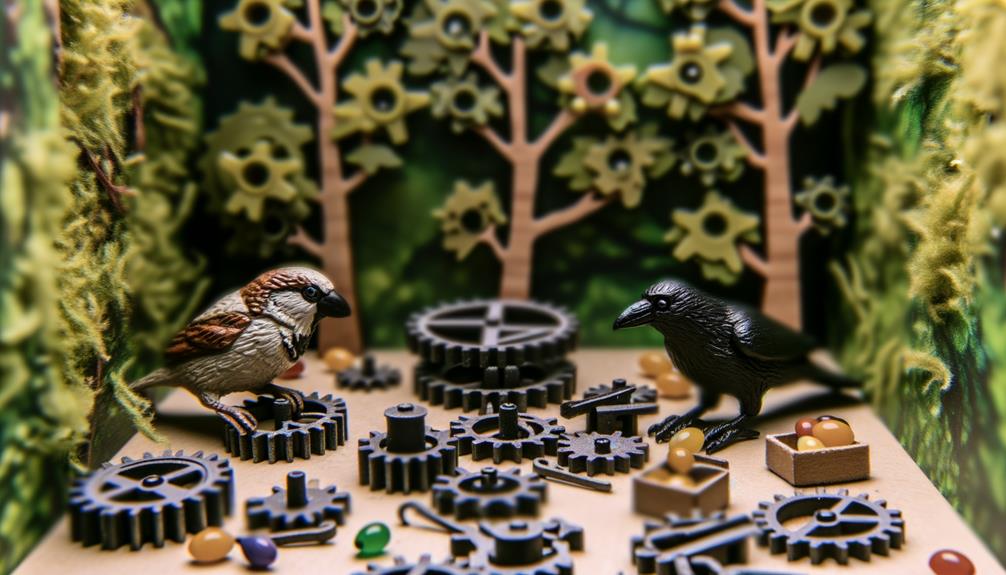
Crows exhibit remarkable intelligence through their use of tools, a behavior rarely observed in sparrows. Studies have shown crows’ adeptness at using sticks to extract insects from tree bark, demonstrating advanced problem-solving abilities.
Additionally, crows display impressive memory retention and learning capability, contrasting with the relatively simpler cognitive functions observed in sparrows.
Tool Use Comparison
Observing avian behavior reveals that sparrows exhibit basic problem-solving skills, whereas crows demonstrate advanced tool use and cognitive capabilities.
Sparrows, though adept at foraging, lack the complex manipulative behaviors seen in crows.
Crows, particularly the New Caledonian species, employ sticks and leaves to extract insects from tree bark, showcasing remarkable ingenuity. They even fashion hooks from twigs, a behavior indicative of higher cognitive functions.
Experimental studies reveal that crows can solve multi-step puzzles, indicating sophisticated planning and foresight. In contrast, sparrows typically utilize simpler strategies like pecking and probing.
This sharp contrast underscores the cognitive disparity between the two species, highlighting the crow’s exceptional problem-solving prowess through tool use, a demonstration of their superior intelligence.
Memory and Learning
Many avian studies reveal significant differences in memory retention and learning capabilities between sparrows and crows, with the latter showing superior problem-solving skills. Crows exhibit remarkable episodic memory, recalling intricate details of past events. They employ advanced cognitive strategies, like causal reasoning, to solve complex puzzles. Sparrows, although adept at song learning and spatial navigation, don’t match crows in these cognitive tasks.
Here’s a detailed comparison:
| Aspect | Sparrow | Crow |
|---|---|---|
| Memory Retention | Moderate | High |
| Learning Capabilities | Song learning, spatial navigation | Problem-solving, tool use |
| Problem-Solving Skills | Basic | Advanced |
These observations underscore crows’ advanced intelligence, offering a sense of wonder and freedom in understanding avian cognition.
Social Behavior
In social interactions, sparrows exhibit intricate hierarchies and clear communication signals, while crows demonstrate remarkable cooperation and problem-solving abilities. Sparrows rely on vocalizations and physical displays to establish dominance and maintain social order within flocks. These behaviors guarantee efficient resource allocation and breeding opportunities.
Crows, on the other hand, form complex social structures and display advanced cognitive skills. They engage in cooperative breeding, food sharing, and exhibit tactical deception. Such behaviors indicate a high level of social intelligence. Both species showcase different yet sophisticated social strategies that enable them to thrive in varied environments.
Sparrows’ structured hierarchies contrast with crows’ collaborative efforts, highlighting the diversity of avian social behaviors and their adaptability to ecological pressures.
Habitat Preferences

Sparrows favor open, grassy areas with scattered shrubs and trees, while crows thrive in a wide range of environments, from urban landscapes to dense forests. Sparrows exhibit a preference for habitats that provide ample foraging opportunities and cover from predators. Their nesting sites often include thick vegetation or human-made structures like eaves and gutters.
In contrast, crows demonstrate remarkable adaptability, inhabiting both rural and metropolitan areas. They exploit diverse food sources and are frequently observed in agricultural fields, city parks, and suburban neighborhoods. Crows’ intelligence allows them to navigate complex environments, using urban settings for nesting and scavenging.
These distinct habitat preferences highlight the sparrow’s reliance on specific conditions and the crow’s versatile survival strategies, offering insights into their respective ecological niches.
Role in Ecosystem
Both sparrows and crows play important roles in their ecosystems, influencing food webs, seed dispersal, and pest control dynamics. Sparrows primarily consume seeds and insects, aiding in seed dispersal and controlling insect populations. Crows, being omnivores, scavenge carrion, disperse seeds, and prey on small animals, supporting ecological balance.
| Species | Primary Diet | Ecological Role |
|---|---|---|
| Sparrows | Seeds, insects | Seed dispersal, pest control |
| Crows | Omnivorous | Scavenging, seed dispersal, predation |
| Both | Varied | Biodiversity support |
Their interactions with other species provide critical ecosystem services. For instance, sparrows’ insect consumption can reduce pest populations affecting crops, while crows’ scavenging habits help in nutrient recycling. Such behaviors underscore their ecological significance, promoting a balanced environment.
Cultural Significance
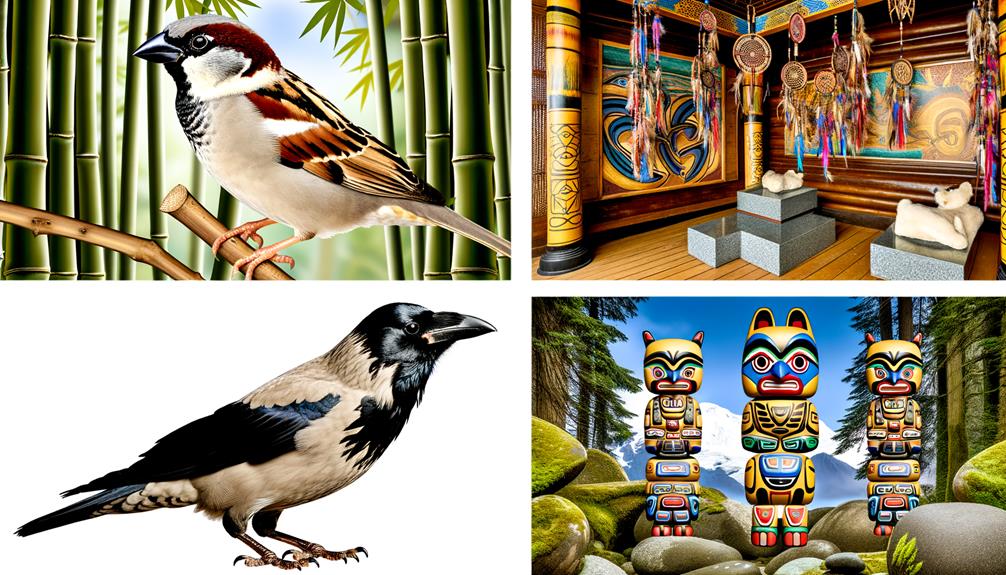
Throughout history, crows and sparrows have held significant places in various cultures, often symbolizing contrasting themes such as wisdom and simplicity. Crows, known for their remarkable cognitive abilities, appear in mythology as harbingers of fate and symbols of intelligence. In Norse mythology, Odin’s ravens, Huginn and Muninn, embody thought and memory, exploring the world and reporting back to their master.
Conversely, sparrows represent modesty and domestic tranquility. In Chinese culture, they symbolize joy and community, often depicted in traditional artwork. Behavioral studies reveal crows’ problem-solving skills and social complexity, while sparrows exhibit strong nesting instincts and communal behavior.
These distinct traits underscore their cultural symbolism, reflecting humanity’s admiration for both intellectual prowess and humble perseverance.
Conclusion
In the grand tapestry of nature, the sparrow and the crow each play unique roles. While the sparrow flits about with delicate grace, the crow’s commanding presence can’t be ignored.
Their distinct vocalizations, varied diets, and contrasting social structures illuminate their ecological niches. Observing these avian wonders, one can’t help but marvel at the intricate balance they maintain.
Truly, their differences don’t divide them; instead, they demonstrate nature’s boundless ingenuity and adaptability.

